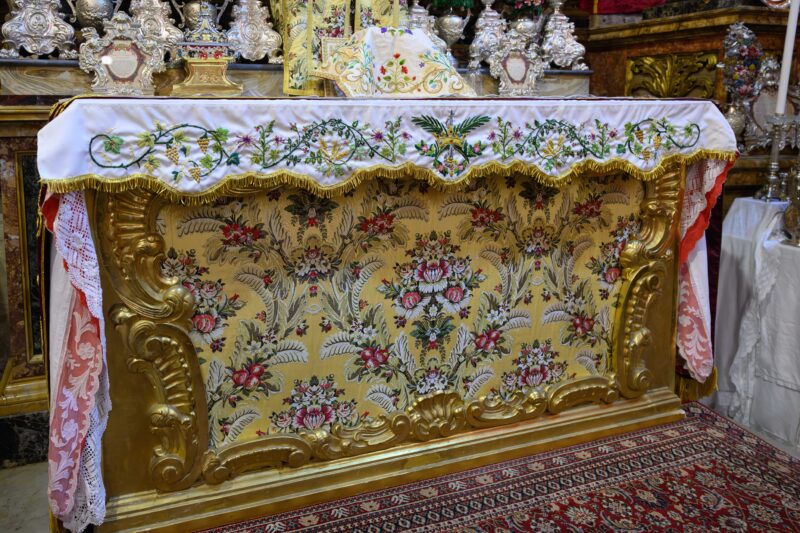A few weeks ago, we spoke about the altar cards that are displayed on the altar during the feast days in our churches. But there are other things that we might find odd or not quite understand. Among these are the cloths that cover the altars because there’s not just one or two of them, but four! These cloths often feature fine Maltese lace along the edges—as if one cloth is trying to outdo the other—or the most delicate embroidery, as is fitting for the ‘table’ upon which the Eucharist is celebrated. But exactly why is all this laid out?
The General Instruction of the Roman Missal stresses that the only altar to be adorned and decorated should be the one on which the Mass is being celebrated, precisely because the altar itself is a symbol of Christ, who “for our salvation, showed himself the Priest, the Altar, and the Lamb of sacrifice” (see Preface V of Easter). Although other altars were not need to be removed, they should not be specially decorated in a way that distracts the faithful from this one focal point (see par. 303). Nevertheless, in our country, the tradition of decorating all altars has been maintained, according to the norms prior to the liturgical reforms of Vatican Council II when there was a more ‘private’ understanding of the Mass.
Even though today this may appear simply as decoration, these side altars were once also in use—sometimes with masses celebrated simultaneously in the same church. Those who are older may remember how some parishioners would move from one altar to another—even if they had already started hearing Mass—when the bell signalled a priest they preferred, or one who celebrated Mass more quickly, emerging from the sacristy! Liturgical norms may change, but it’s not quite so easy to change the mindset of a people …
Where side altars continue to be decorated, it’s likely that this is still being done in accordance with older liturgical norms which prescribed that, on an altar where the Eucharist was to be celebrated, three linen cloths made of pure linen were to be laid, and sometimes a fourth cloth covering just the altar stone would be added. These cloths symbolise the linen shroud in which Christ was wrapped when He was taken down from the cross and laid in the tomb, as we are told in the Gospel of John (19:40). The use of the three altar cloths probably dates back to the ninth century and had a practical purpose: to absorb the Blood of Christ in case it was accidental spilled.
When Mass is not being celebrated, the altar would be covered with what is known as the sopra terħa (literally, top cloth), to protect it from dust while not in use—thus referred to as vesperal cloth. During feast days, the sopra terħa is generally made of red velvet with gold embroidery, but in ordinary times, it used to be of a green colour and made of a simpler material. If we stretch the symbolic meaning a bit further, we could liken the sopra terħa to the scarlet robe that the Roman soldiers placed on Jesus while they mocked Him—which, according to the Synoptic Gospels, was taken off before Jesus was taken to be crucified. In the same way, the vesperal cloth is removed for the celebration of Mass, where Christ once again makes Himself present and offers us a share in His sacrifice, which was made once and for all on Calvary (see Hebrews 7:27).




